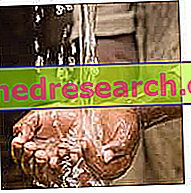Generality
Hepatitis E is a liver disease caused by HEV, a small non-capsulated RNA virus that - similar to the hepatitis A causative agent - is transmitted via the fecal-oral route, therefore through the consumption of water and food contaminated by infected faeces .

Hepatitis E is fortunately rare in Italy, as indeed in other industrialized countries, while it is often present in epidemic or sporadic form in developing regions, where overcrowding and precarious hygienic conditions constitute fertile ground for its spread.
Symptoms
To learn more: Symptoms Hepatitis E
After the infection the incubation period varies from two to nine weeks; on average it lasts about 40-50 days.
The disease therefore begins with a symptomatological procession similar to that of hepatitis A (jaundice, anorexia, malaise, abdominal and articular pain, high fever); the symptoms are more serious in pregnant women, so that in a not inconsiderable percentage of cases (around 10-20%) the virus is responsible for fulminant hepatitis.
Contagion and Prevention
Particular attention, therefore, when one goes to developing countries, where it is necessary to respect some simple rules, such as the fact of thoroughly rinsing the vegetables and fruit, and peel the latter before consumption. Furthermore, it is very important to consume meat and fish (especially molluscs) only after generous cooking.
Beyond food, water is a very important vehicle of infection; that taken from the tap or from common sources should always be boiled for at least 5-10 minutes, while the bottled one can be consumed with greater tranquility, as long as it is uncorked before your eyes. Also pay attention to the ice cubes - which should never be consumed directly or added to the drinks - and to the water used to brush your teeth: it should also be safe, so it should be safe to bottle. Likewise, when bathing in rivers and seas, care should be taken that no water enters the mouth.
The individual prevention of hepatitis E is completed with the common rules of personal hygiene, such as the accurate and frequent washing of hands, especially after having been to the toilet and before handling food; finally, objects such as toothbrushes, cutlery, glasses and towels should be used strictly for personal use.
In addition to humans, the HEV virus also affects some animals, including pigs and cervids; episodes of transmission of the infection have been described after eating raw boar and venison; however, the real danger of this possible route of contagion remains to be clarified. In any case, for safety, it is advisable to consume pork only after adequate cooking (caution useful for preventing various other diseases, such as toxoplasmosis).
Treatment
Cases of hepatitis E tend to be self-limiting and hospitalization is generally not required; there is no specific and really effective therapy, which is why prevention remains by far the most important intervention; a vaccine of recombinant origin, able to prevent the disease, is already available in China.
Continue: Hepatitis E Treatment Medicines »



